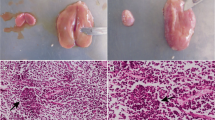Abstract
Twelve each of Red Masai and Dorper sheep, aged between 6 and 9 months, were acquired from a Fasciola-free area of eastern Kenya. Each breed was divided into two groups of 6. The sheep in one group of each breed were experimentally infected with 400 viable metacercariae of Fasciola gigantica. The other group of 6 sheep of each breed remained as uninfected controls. The animals were monitored regularly for any evidence of disease. Blood samples taken weekly revealed a general reduction in red cell counts and packed cell volume, which was much faster in the infected Dorper sheep than in the Red Masai. This reduction started from the tenth week after infection and persisted to the end of the experiment 18 weeks post infection (PI). The absolute eosinophil counts rose in all the infected animals, but the values were higher among the Dorper than among the Red Masai. Patency occurred at weeks 12 and 13 PI in the Red Masai and Dorpers, respectively, with the latter shedding significantly more fluke eggs. The worm recovery rates were higher among the Dorpers than among the Red Masai, though not significantly so. On the basis of egg counts and clinicopathology, the Dorper sheep were considered to be more susceptible to F. gigantica infections.
Similar content being viewed by others
REFERENCES
Ackerman, S.J., Gleich, G.J., Weller, P.F. and Ottensen, E.A., 1981. Eosinophilia and elevated serum levels of eosinophil major basic protein and Charcot-Leyden crystal protein (lysophospolipase) after treatment of patients with Bancrofts Filariasis. Journal of Immunology, 127, 1093-1094
Boray, J.C. and Pearson, I.G., 1960. Anthelmintic efficiency of tetrachlorodifluoroethane in sheep infested with Fasciola hepatica. Australian Veterinary Journal, 36, 331-337
Boyce,W.M., Courtney, C.H. and Loggins, P.E., 1987. Resistance to experimental infection with Fasciola hepatica in exotic and domestic breeds of sheep. International Journal for Parasitology, 17, 1233-1237
Dargie, J.D., 1973. Fasciolosis: pathophysiology. In: G.M. Urquhart and J. Armour (eds), Helminth Diseases of Cattle, Sheep and Horses in Europe, (Robert Maclehose, The University Press, Glasgow), 87-92
Kadhim, J.K., 1976. Haematological changes during the course of experimental infection with Fasciola gigantica in sheep. In: E.J.L. Soulsby (ed.), Pathophysiology of Parasitic Infections, (Academic Press, New York), 105-114
McGregor, R.G.S., Richards, W. and Loh, G.L., 1940. The differential leukocyte count. Journal of Pathology and Bacteriology, 51, 337-368
Ngategize, P.K., Bekele, T. and Tilahun, G., 1993. The financial losses caused by ovine fasciolosis in the Ethiopian highlands. Tropical Animal Health and Production, 25, 155-161
Preston, J.M. and Allonby, E.W., 1978. The influence of breed on the susceptibility of sheep and goats to a single experimental infection with Haemonchus contortus. Veterinary Record, 103, 509-512
Preston, J.M. and Allonby, E.W., 1979. The influence of breed on the susceptibility of sheep to Haemonchus contortus in Kenya. Research in Veterinary Science, 26, 134-139
Sinclair, K.B., 1967. Physiological aspects of fasciolosis. Proceedings of the Second International Liverfluke Colloquim, Wageningen, The Netherlands, 123-124
Wiedosari, E. and Copeman, D.B., 1990. High resistance to experimental infection with Fasciola gigantica in Javanese thin tailed sheep. Veterinary Parasitology, 37, 101-111
Author information
Authors and Affiliations
Rights and permissions
About this article
Cite this article
Waweru, J., Kanyari, P., Mwangi, D. et al. Comparative Parasitological and Haematological Changes in Two Breeds of Sheep Infected with Fasciola gigantica. Tropical Animal Health and Production 31, 363–372 (1999). https://doi.org/10.1023/A:1005221108013
Issue Date:
DOI: https://doi.org/10.1023/A:1005221108013




